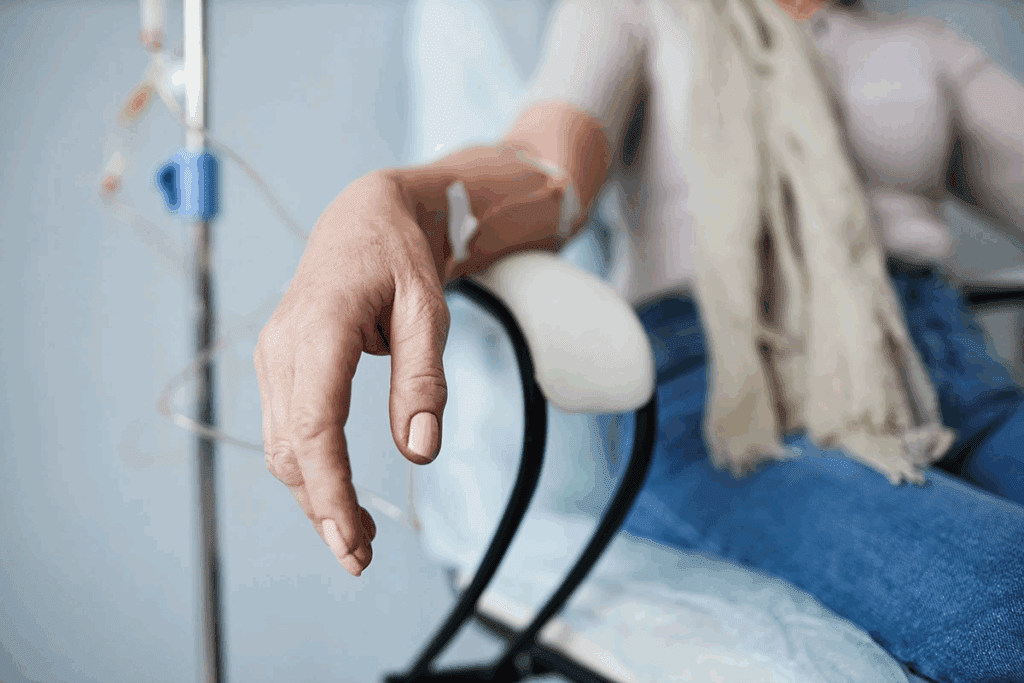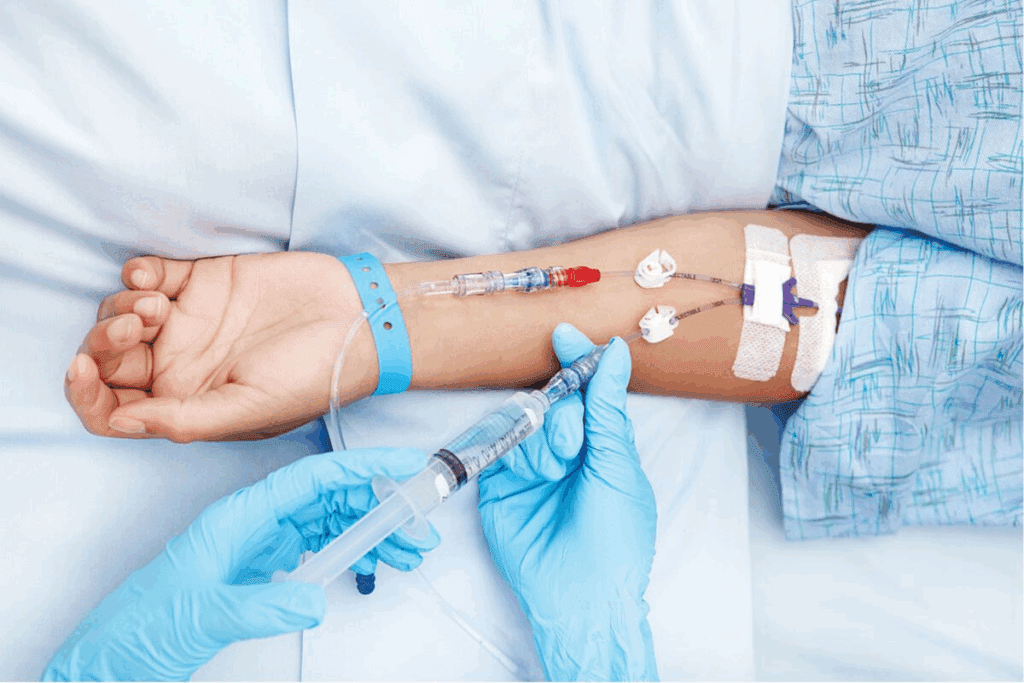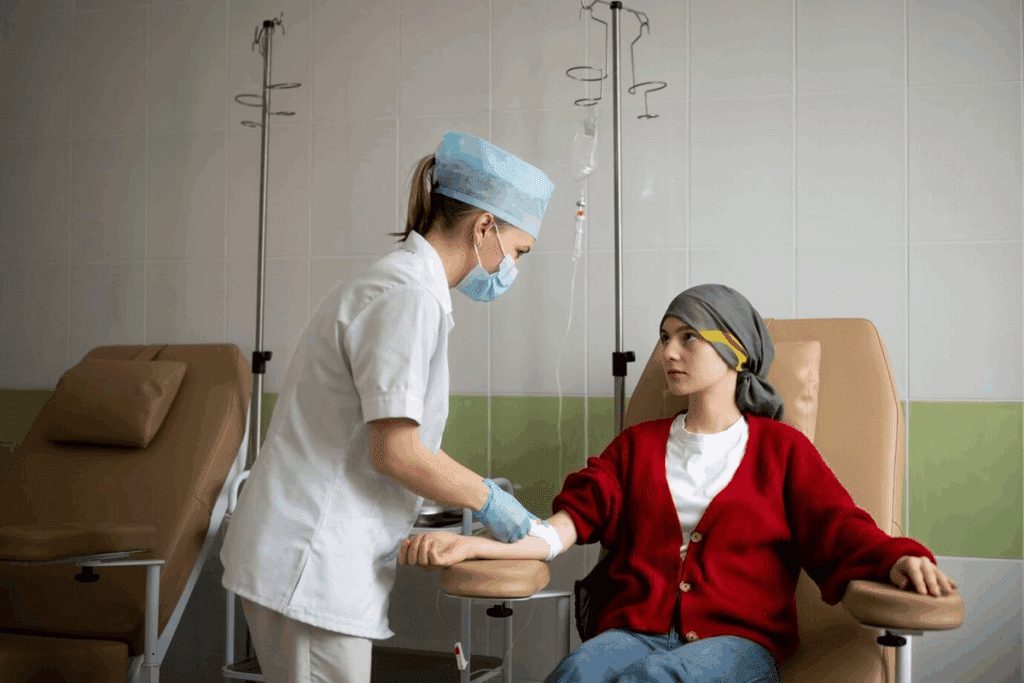Last Updated on November 20, 2025 by Ugurkan Demir

Chemotherapy is a treatment that uses medicines to fight cancer. But, chemotherapy risks are real. In rare cases, it can lead to severe side effects or even death.
At Liv Hospital, we know how important it is to weigh the good and bad of chemotherapy. Our focus is on you, making sure we do everything we can to keep you safe from chemotherapy risks.
Let’s talk about the risks and benefits of chemotherapy. In this article,chemo without side effectsHow Painful Is Targeted Therapy? 1st Chemo Treatment Side Effects Explained we’ll look at the dangers of chemotherapy and what you might experience during treatment.

Chemotherapy plays a vital role in fighting cancer. It targets cells that grow quickly. This treatment uses drugs to kill or stop cancer cells from growing.
Chemotherapy works by targeting cells that are in the process of dividing, a characteristic common to most cancer cells.
Chemotherapy drugs can be taken by mouth or given through an IV. They travel through the blood to find and destroy cancer cells. This systemic approach allows chemotherapy to treat cancer that has spread to different parts of the body.
There are different types of chemotherapy drugs. These include:
Understanding how chemotherapy works helps patients see its benefits and risks. It’s often used with other treatments like surgery and radiation to get the best results.
Chemotherapy is a powerful tool against cancer but comes with risks. Its benefits include:
But, chemotherapy also has risks and side effects, such as:
It’s important to weigh the benefits against the risks of chemotherapy. The key is finding a balance that works for each individual, considering their condition, health, and preferences.
“The goal of chemotherapy is to cure cancer, control its growth, or alleviate symptoms. Understanding the balance between its benefits and risks is key for informed decisions.”

The link between chemotherapy and death is complex. Treatment can sometimes cause life-threatening side effects. It’s key for patients and doctors to know the risks of chemotherapy.
How often chemotherapy leads to death varies. It depends on the cancer type, patient age, and health. Some chemotherapy can cause severe side effects like neutropenia, leading to dangerous infections.
Key statistics on chemotherapy-related mortality include:
It’s hard to tell if death is from cancer getting worse or treatment side effects. Knowing the cause is key to understanding chemotherapy risks. It helps improve treatment plans.
Factors considered when attributing cause of death include:
By looking at these factors, doctors can better grasp chemotherapy risks. They can then work to reduce them.
Knowing the side effects of chemotherapy is key for those starting treatment. Chemotherapy fights cancer well but can affect daily life. It’s important to understand these effects.
Short-term side effects happen during or right after treatment. These include:
Some effects last long after treatment or show up years later. These include:
| Side Effect | Short-Term | Long-Term |
| Fatigue | Common | Possible |
| Hair Loss | Common | Rare |
| Nausea/Vomiting | Common | Rare |
| Cardiac Issues | Rare | Possible |
| Nerve Damage | Rare | Possible |
Talking to your healthcare provider about side effects is vital. Knowing what to expect helps patients prepare for chemotherapy’s challenges.
Chemotherapy is a lifesaver but can also lead to severe complications. These can be life-threatening and need immediate medical care. We will look at the main risks of chemotherapy. This will help patients and their caregivers know what to watch for and how to manage these side effects.
Neutropenia is a big risk with chemotherapy. It’s when you have too few neutrophils, a key white blood cell. Without enough neutrophils, you’re more likely to get infections. These infections can be very serious and even life-threatening. Neutropenia is a medical emergency that needs quick treatment, often in the hospital.
Patients should watch for signs of infection like fever, chills, and a persistent cough. If you notice these, get medical help right away. To lower the risk, practice good hygiene and avoid sick people.
Chemotherapy can also harm organs, leading to long-term health problems or even organ failure. Some drugs can damage the heart, causing heart failure. Others can harm the kidneys, affecting their function.
Monitoring organ function during treatment is key. Tests like echocardiograms and blood tests can spot problems early. Changing the treatment plan or using protective measures can help reduce these risks.
Chemotherapy can also increase the risk of getting secondary cancers. Some treatments can damage healthy cells’ DNA, leading to new cancers years later. While the risk is low, it’s a big concern to discuss with your doctor.
The risk of secondary cancers shows the need for careful treatment planning and ongoing care. Patients who have had chemotherapy should keep up with regular check-ups. This helps monitor for new cancers or other late effects of treatment.
Chemotherapy comes with risks, making it a big decision. Knowing these risks helps patients and doctors make better choices.
People with health issues face higher risks with chemotherapy. Heart disease, diabetes, and kidney or liver problems can make treatment harder. Some drugs can worsen heart conditions or harm kidneys.
Age and frailty affect how well someone can handle chemotherapy. Older people or those who are frail might face more side effects.
Frailty means losing weight, getting weaker, and being less active. It makes it harder for the body to handle chemotherapy. Checking frailty and overall health is key to choosing the right treatment.
The dose and mix of chemotherapy drugs matter a lot. Higher doses or some mixes can lead to more side effects.
It’s important to balance the benefits and risks to find the best treatment for each patient.
Cancer treatment is changing, focusing on lessening chemotherapy side effects. We’re seeing big steps forward in cancer care. These steps aim to lessen the tough impacts of traditional chemotherapy.
Targeted therapies are a big change in cancer treatment. They don’t harm healthy cells like old chemotherapy did. This makes treatments better and side effects less.
Precision medicine goes even further. It tailors treatments to each patient’s genes. This way, treatments are more likely to work and cause fewer side effects.
Supportive treatments are also key in managing side effects. They include medicines for nausea and treatments to help blood cells grow. These help patients get better after chemotherapy.
There’s a growing focus on integrative care too. It mixes traditional medicine with complementary therapies. This includes nutrition advice, mind-body therapies, and exercise programs. All these aim to make patients’ lives better during and after treatment.
By using these modern methods together, we can greatly lessen chemotherapy side effects. This makes treatment easier to handle and improves cancer patients’ outcomes.
Choosing to have chemotherapy is a big decision. It involves weighing the benefits against the risks. This choice is very important for patients and their families as they face cancer treatment.
Chemotherapy works differently for each cancer and at each stage. For some, it can cure the disease. For others, it helps manage symptoms or slow the disease’s growth. We look at the cancer type, the patient’s health, and possible side effects to decide.
Curative vs. Palliative Chemotherapy: If chemotherapy can cure the cancer, the benefits are usually greater than the risks. But when it’s used to improve life quality, the decision is more complex.
How chemotherapy affects a patient’s life is key. We think about survival benefits and how treatment impacts daily life. This includes physical health, emotional state, and social interactions.
Supportive Care: New ways to manage chemotherapy side effects have improved life during treatment. We focus on care that meets both physical and emotional needs.
Deciding on chemotherapy is a personal choice. We consider the cancer type, the patient’s health, and life quality impact. This helps us decide if chemotherapy is right for them.
Safer chemotherapy is now a reality thanks to patient-centered approaches. These focus on personalized treatment plans. By tailoring treatment to each patient’s needs, we can make chemotherapy more effective and safer.
Personalized treatment plans are key in patient-centered care for chemotherapy. They consider each patient’s medical history, genetic profile, and lifestyle. This way, we can find the best treatment with fewer side effects.
Studies show that personalized medicine is improving patient outcomes in cancer treatment.
Genetic testing helps find the right chemotherapy drugs for patients. It also predicts who might face severe side effects. This lets doctors adjust treatments to make them safer and more effective.
Effective monitoring and management of side effects are key in patient-centered chemotherapy care. Regular checks help catch problems early. This allows for quick action to prevent severe side effects.
Patients should tell their doctors about any symptoms or concerns. This helps doctors adjust treatment plans to balance benefits and risks. Supportive care, like medications for nausea or pain, can also be added to improve patient comfort.
By focusing on patient-centered approaches to chemotherapy, we’re making big strides. We’re improving treatment outcomes and the quality of life for cancer patients. As we move forward in oncology, personalized care will remain essential for effective cancer treatment.
At Liv Hospital, we focus on safer cancer treatment. We use the latest methods to make chemotherapy safer and more effective.
We use the newest medical tech and treatments to give our patients the best care. Our protocols aim to lessen chemotherapy side effects and improve results.
Key Components of Our Advanced Protocols:
Supportive care is key at Liv Hospital. We know cancer treatment is more than just medicine. It’s about the patient’s overall well-being.
| Supportive Care Measures | Description | Benefits |
| Nutritional Counseling | Personalized dietary advice to manage side effects and maintain strength. | Improved nutritional status, better tolerance to treatment. |
| Psychological Support | Access to counseling and therapy to address emotional and psychological needs. | Reduced anxiety and depression, enhanced coping mechanisms. |
| Pain Management | Comprehensive pain assessment and management strategies. | Improved quality of life, reduced pain. |
We add these supportive care steps to our treatment plans. Our goal is to improve our patients’ lives and treatment experiences.
It’s key for patients to know the risks and benefits of chemotherapy. This knowledge helps them make smart choices about their treatment. Chemotherapy can save lives but also has risks and side effects, like “chemobrain.”
Things like health before treatment, age, and how much chemotherapy is used can affect these risks. New treatments try to lessen these problems.
Also, about half of all cancers could be prevented by living healthy. It’s hard to weigh the good against the bad of chemotherapy. Many people struggle to understand the numbers about risks and treatment results.
For more on this, check out research on the National Center for Biotechnology Information.
Patients can make better choices by knowing about chemotherapy’s risks and benefits. Personalized treatment plans and supportive care are key. This approach, like at Liv Hospital, helps reduce risks and increase benefits.
Chemotherapy is a lifesaving treatment but can have severe side effects. These can be life-threatening in some cases. Yet, deaths directly from chemotherapy are rare.
Common side effects include nausea, vomiting, hair loss, and fatigue. There’s also a higher risk of infections. Some side effects are short-term, while others can last long after treatment.
Chemotherapy can cause severe complications like neutropenia. This increases the risk of infections and organ damage. The risks depend on the type of chemotherapy, dosage, and individual factors.
Yes, pre-existing health conditions, age, and frailty can increase risks. Certain chemotherapy dosages and drug combinations also play a role. Understanding these factors helps in making informed treatment decisions.
Yes, modern approaches like targeted therapies and precision medicine aim to reduce side effects. Supportive treatments also help manage and mitigate side effects.
The decision is based on the risk-benefit ratio for different cancers. It considers the impact on quality of life. Patients and healthcare providers weigh the benefits against the risks and side effects.
It involves developing personalized treatment plans. These plans are tailored to the individual patient’s needs. Close monitoring and managing side effects are key to minimizing risks.
Liv Hospital uses advanced protocols to minimize chemotherapy risks. It provides integrated supportive care during treatment. This emphasizes high-quality, patient-centered care.
The worth of chemotherapy varies by cancer type, stage, and individual factors. For some cancers, it is highly effective and worth the risk. For others, the benefits may be more limited.
Chemotherapy can be curative for certain types of cancer by killing cancer cells. Success depends on various factors, including the type and stage of cancer.
Long-term side effects can include heart problems, secondary cancers, and neurological issues. The risk varies depending on the chemotherapy regimen and individual factors.
Subscribe to our e-newsletter to stay informed about the latest innovations in the world of health and exclusive offers!